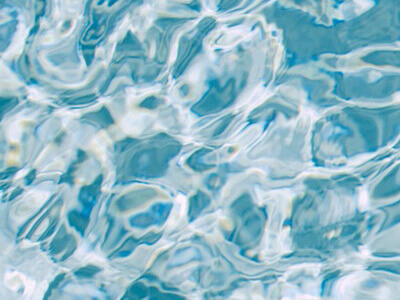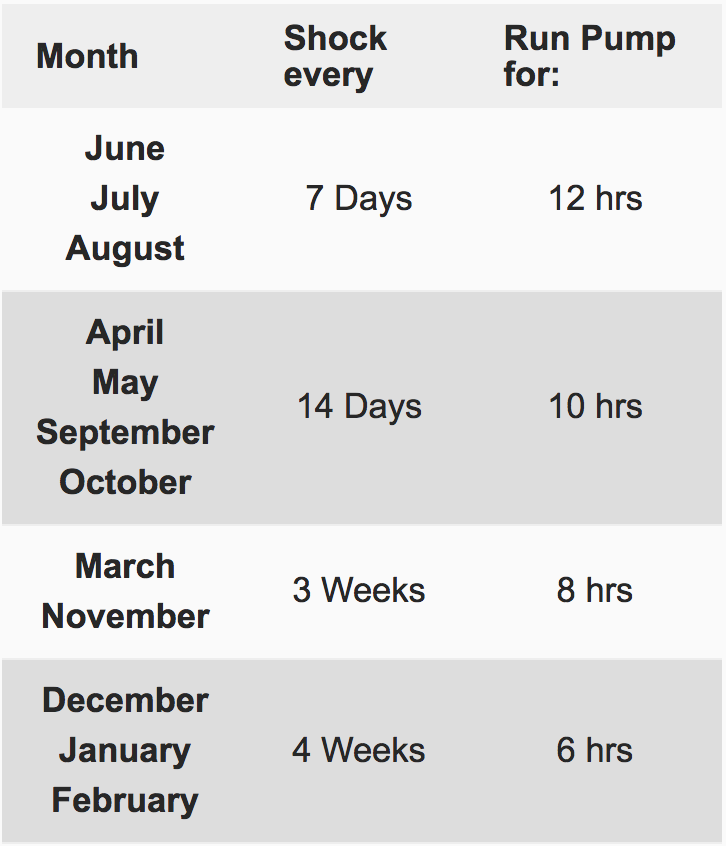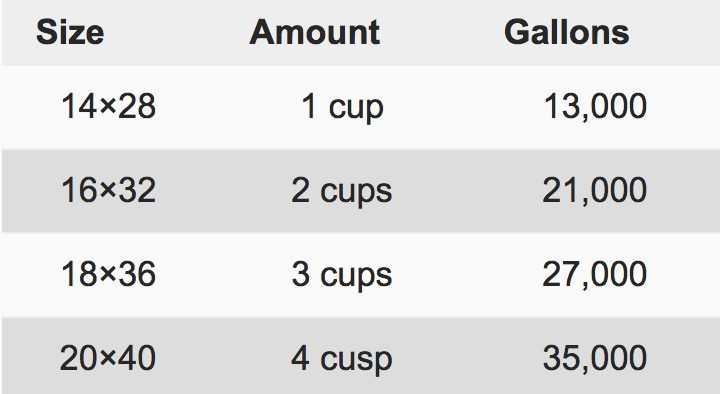
Weekly Maintenance
- Either run Polaris or manually vacuum pool
- Backwash the pool for 2 min.
- Rinse pool for 1 min.
- Add 3 to 4 chlorine tablets to automatic chlorinator
- Clean pump basket.
- Clean skimmer basket.
- Shock according to test kit results or pool analysis given within the store.
REMEMBER: Part of weekly maintenance is to check chemical levels with a home test kit. Maintaining good pH level is probably the most important factor in pool chemistry, swimmer comfort, and longevity of liner. Alsoas the weather heats up and afternoon thunderstorms roll in, pool maintenance tends to reach a new level. Chemicals are leached out of your pool due to three common summertime conditions:
- Rainfall
- Hot weather
- Swimmer load
All three conditions require you to watch the chlorine level in your pool and regulate it weekly.
If you manually feed chlorine into your pool, keep your chlorinator full of TriChlor tablets and be sure to shock every 4-5 days to stay ahead of the game. It would not hurt to run your pump at least 15 hours daily to ensure your water is properly filtered.
Basic Shock Schedule

The shocking schedule may vary according to the weather. When temperature is freezing or below run filter at all times.
You must wait 3 hrs before swimming after pool has been shocked!
Shock Dosage

Granular Chlorine
Granular chlorine is a shock treatment, which combats large amounts of bacteria to be added through the skimmer according to the shock schedule.
Big tabs or slow sticks are used for the automatic chlorinator, which provides a daily supply of chlorine to insure clean fresh water. Dissolve slowly in a bucket of water to provide steady chlorination. Never mix name brand chlorine in the chlorinator, because there is a risk of an explosion. Never use granular chlorine in the automatic chlorinator.
How to clean the cell on a salt chlorination system
Mix a solution of 1 part muratic acid and 4 parts water in a clean 5 gallon bucket. Then submerge cell into solution for 30 seconds to 1 minute. Remove cell from solution and rinse thoroughly. (Caution: always wear safety equipment when handling dangerous liquids and refer to owner’s manual for proper cell removal and handling!)
pH
pH is the most important factor in balancing your water. When pH level is out of range it will make all the other chemicals unbalanced. The proper reading is 7.4-7.6. Readings below or above can result in swimming discomfort. Such as eyes burning and skin irritation, high chlorine consumption may cause wrinkles in the pool liner. Proper pH control is the key to swimming comfort and long life of the pool.
pH down (Sodium Bisulphate)-used for lowering the pH level in your pool.
Algaecide
Algaecide kills and prevents the growth of algae in the pool. This should be added to the pool. This should be added to the pool any time the steps or the liner becomes slimy. Concentrated algaecide should be diluted into a bucket of water and pour around the edge of the pool and leave the filter on for 36 hrs. After that is completed manually vacuum the pool on waste, then backwash and rinse.
Water Clarifier
Clarifier is used when the pool water is cloudy. It removes particles to small to be trapped by the sand. Concentrated clarifier should be diluted into a bucket of water and poured around the edge of the pool. Leave the filter on for 24hrs. After that is completed manually vacuum the pool, then backwash and rinse.
Surface Cleaner
Surface cleaner is used to remove the “bathtub ring” from around the pool liner. To prevent, keep a scumball in the skimmer basket. Change the scumball when necessary.
Note: Whenever you are doing a chemical treatment for your pool which requires dilution, always put the chemicals into a bucket of water. Never pour chemicals into an empty bucket and add water with a garden hose. This will help prevent harmful splashes to the eyes or skin.
Water Level
The water level should be at the second screw from the top of the skimmer facing. Failure to keep the water at this level will allow air to be pulled through the filter. It is normal to loose ½ inch in a day’s time from evaporation. Just place the garden hose into the pool to replenish the water loss. If the water should drop more than 1 inch in a day’s time it is possible that there is a leak, and you should contact the office.
What to do during heavy rains
Always keep water level as close to top of liner or tile as possible without overflowing during heavy rain. For extensive rain periods maintain high water levels without overflowing for 2-3 days.
Timer Schedule
How to use the manual vacuum
- First turn the main drains off so all suction is derived from the skimmer and start the filter pump.
- Then assemble the manual vacuuming equipment and submerge the vacuum pole with the attached vacuum head into the pool along with the hose until the end of the hose with the attached skim-vac is at water level.
- Then secure the skim-vac down into the skimmer with the basket in the skimmer. Slowly vacuum pool until clean or basket is full.
- Once finished, clean filters.
Polaris use and care
- Polaris should not be used every day. Daily use can wear out the Polaris and liner.
- Polaris should only be used about 3-4 hrs to clean the entire pool.
- Store Polaris out of sunlight when not in use. Never leave in the pool when not in use.
- Never swim with the Polaris in the pool.
- Sluggish movement indicates trash in the strainer at the wall connection.
- Always rinse the strainer and silt bag after every use.
- Scum on the tire should be cleaned with the tile and vinyl surface cleaner.
- Occasionally lay out the Polaris tail and hoses to dry out the floats and lines.
- Wheels that are not turning indicate small gravel or debris in the wheel and axle groove.
Nature II
- Get water balanced before placing cartridge in filter.
- Once water is balanced run pool for 4 days. While maintaining 1.5 chlorine.
- Then after 4 days return to normal filtering time according to seasons.
- Shock your pool every other week or as needed indicated by the test kit.
- Keep chlorinator valve on 4 year round.
Remember: Replace nature II cartridge every 6 months. The chlorine level in the pool should be at least .30-1.00. The best way to know when to shock is to test your water. When pool becomes cloudy test pH, if OK shock pool and put algaecide plus in the pool.








